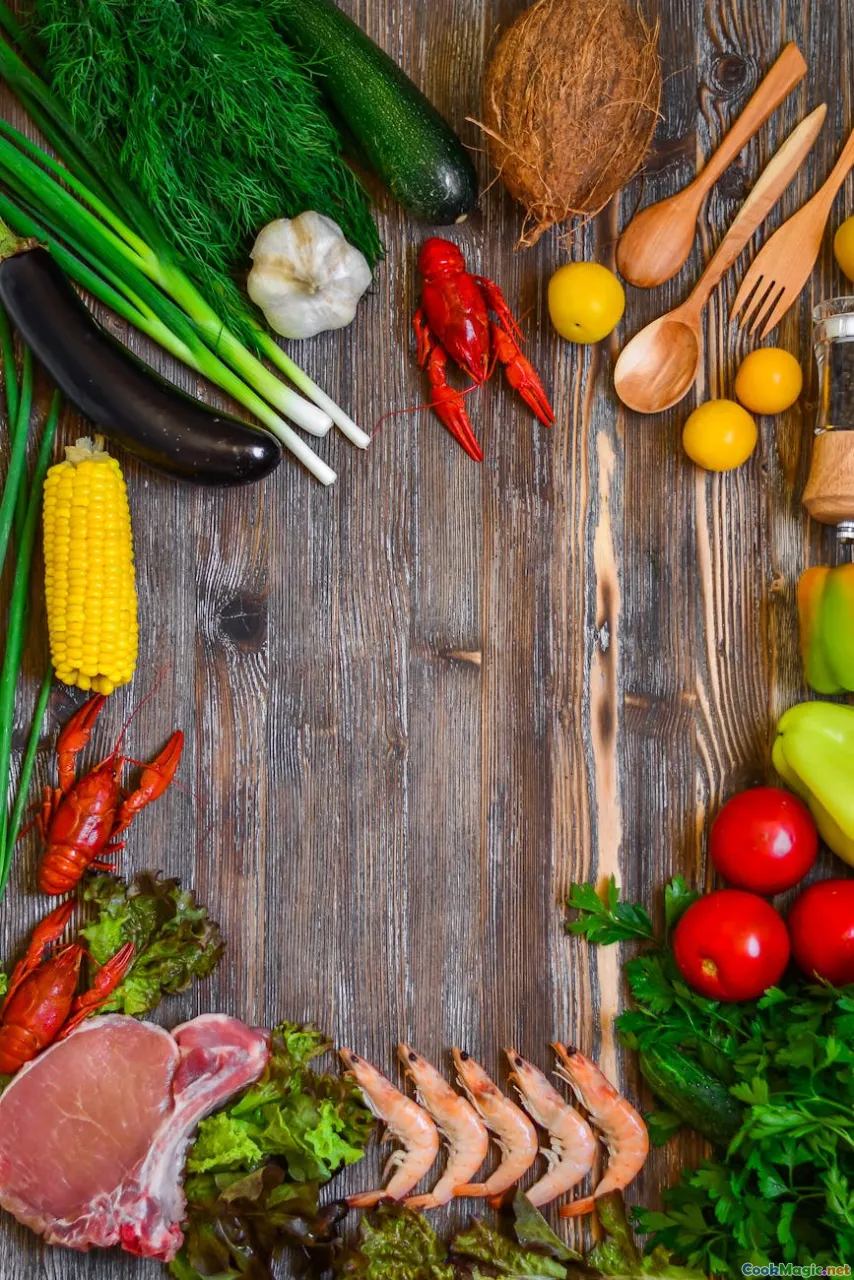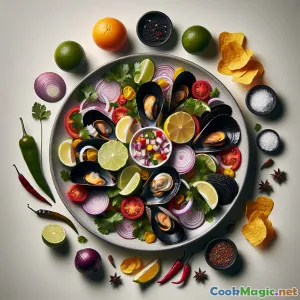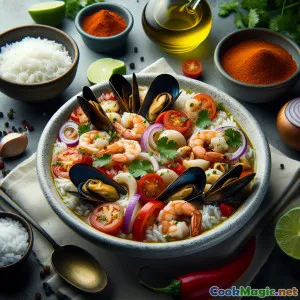
Encocado de camarão com banana-da-terra caramelizada
(Shrimp Encocado with Caramelized Plantain)
(0 Avaliações)0
316
novembro 09, 2025
Reportar um problema
Ingredientes
-
600 grams Camarão grande, descascado e sem veia
(Tails on or off per preference)
-
300 grams Banana-da terra madura
(Yellow with black speckles)
-
400 ml Leite de coco integral
(1 standard can)
-
150 grams Cebola roxa (bem picada)
-
100 grams Pimentão vermelho, picado
-
150 grams Tomate maduro, picado em cubos
(Or 2 Roma tomatoes)
-
4 cloves Alho (picado)
-
30 grams Coentro fresco
(Use stems for sofrito, leaves to finish)
-
1 tsp Pó de urucum (achiote)
(Or use 2 tbsp achiote oil instead of powder + oil)
-
1 tsp Cominho em pó
-
0.5 tsp Orégano seco
-
2 tbsp Suco de Limão Fresco
(Plus extra wedges for serving)
-
200 ml Caldo de peixe ou vegetal
(Water works in a pinch)
-
1 tsp Açúcar mascavo (panela)
(Aids plantain caramelization; balances acidity)
-
2 tbsp Óleo neutro
(Sunflower or canola)
-
1.25 tsp Sal marinho
(Divided, to taste)
-
0.5 tsp Pimenta preta
(Moído na hora)
-
0.5 Pepper Habanero ou ají, picado
(Seeded for less heat)
-
80 grams chips de banana-da-terra verdes (tostones)
(For garnish or side)
-
2 tbsp flocos de coco torrados
(Garnish for texture)
-
2 stalks Cebolinhas, fatiadas finamente
(Green parts for garnish)
-
600 grams Arroz branco cozido
(Acompanhamento tradicional)
-
2 leaves Folhas de banana
(For aromatic serving)
(Tails on or off per preference)
(Yellow with black speckles)
(1 standard can)
(Or 2 Roma tomatoes)
(Use stems for sofrito, leaves to finish)
(Or use 2 tbsp achiote oil instead of powder + oil)
(Plus extra wedges for serving)
(Water works in a pinch)
(Aids plantain caramelization; balances acidity)
(Sunflower or canola)
(Divided, to taste)
(Moído na hora)
(Seeded for less heat)
(For garnish or side)
(Garnish for texture)
(Green parts for garnish)
(Acompanhamento tradicional)
(For aromatic serving)
Nutrição
- Porções: 4
- Tamanho da Porção: 1 tigela (350g)
- Calories: 620 kcal
- Carbohydrates: 55 g
- Protein: 32 g
- Fat: 32 g
- Fiber: 7 g
- Sugar: 12 g
- Sodium: 820 mg
- Cholesterol: 215 mg
- Calcium: 140 mg
- Iron: 3.1 mg
Instruções
-
1 - Marinate the Shrimp:
Pat shrimp dry. Toss with 0.5 tsp salt, black pepper, 0.5 tsp cumin, and 1 tbsp lime juice. Chill while you start the sauce.
-
2 - Caramelize and split the plantain:
Peel ripe plantain and slice into 1 cm rounds. Warm 1 tbsp oil in a skillet. Add plantain and brown sugar; cook until deeply golden on both sides. Reserve half the slices for garnish. Blend the remaining half with coconut milk until smooth.
-
3 - Build the achiote sofrito:
In a wide pot, heat remaining 1 tbsp oil over medium. Stir in annatto powder to bloom (30 seconds). Add onion, bell pepper, tomato, garlic, and chopped cilantro stems with a pinch of salt. Cook, stirring, until glossy and sweet, 6–7 minutes. Add remaining 0.5 tsp cumin and oregano.
-
4 - Create the coconut-plantain sauce:
Pour in stock to deglaze. Add the coconut milk blended with plantain. Bring to a gentle simmer over medium-low, stirring so it doesn’t catch. Season with a pinch of salt.
-
5 - Simmer and balance:
Let the sauce lightly bubble 3–4 minutes until silky and lightly thickened. Taste and adjust salt. Add minced habanero if using for heat.
-
6 - Poach the shrimp gently:
Slide in marinated shrimp and any juices. Simmer just until opaque and curled, 3–4 minutes. Avoid boiling to keep them tender.
-
7 - Finish with brightness:
Fold in remaining lime juice, most of the cilantro leaves, and the reserved caramelized plantain slices. Turn off heat and rest 1 minute.
-
8 - Serve and Garnish:
Line bowls with warmed banana leaves if using. Spoon encocado over rice. Top with tostones, toasted coconut, scallions, and extra cilantro. Serve with lime wedges.
Pat shrimp dry. Toss with 0.5 tsp salt, black pepper, 0.5 tsp cumin, and 1 tbsp lime juice. Chill while you start the sauce.
Peel ripe plantain and slice into 1 cm rounds. Warm 1 tbsp oil in a skillet. Add plantain and brown sugar; cook until deeply golden on both sides. Reserve half the slices for garnish. Blend the remaining half with coconut milk until smooth.
In a wide pot, heat remaining 1 tbsp oil over medium. Stir in annatto powder to bloom (30 seconds). Add onion, bell pepper, tomato, garlic, and chopped cilantro stems with a pinch of salt. Cook, stirring, until glossy and sweet, 6–7 minutes. Add remaining 0.5 tsp cumin and oregano.
Pour in stock to deglaze. Add the coconut milk blended with plantain. Bring to a gentle simmer over medium-low, stirring so it doesn’t catch. Season with a pinch of salt.
Let the sauce lightly bubble 3–4 minutes until silky and lightly thickened. Taste and adjust salt. Add minced habanero if using for heat.
Slide in marinated shrimp and any juices. Simmer just until opaque and curled, 3–4 minutes. Avoid boiling to keep them tender.
Fold in remaining lime juice, most of the cilantro leaves, and the reserved caramelized plantain slices. Turn off heat and rest 1 minute.
Line bowls with warmed banana leaves if using. Spoon encocado over rice. Top with tostones, toasted coconut, scallions, and extra cilantro. Serve with lime wedges.
Mais sobre: Encocado de camarão com banana-da-terra caramelizada
Why this encocado stands out
Encocado, the beloved coastal coconut stew of Ecuador, is most commonly made along the Pacific shores of Esmeraldas and Manabí. Typically prepared with shrimp or fish, it balances the gentle sweetness of coconut milk with savory sofrito, earthy achiote, and a squeeze of lime. This version leans into the region’s abundant plantains by blending caramelized ripe plantain directly into the sauce. The result is a naturally thick, glossy stew with layered sweetness that never turns cloying—thanks to judicious acidity and herbs.
Flavor architecture
- Coconut milk forms the lush backbone of the sauce.
- Achiote (annatto) lends a warm, coastal hue and subtle earthiness.
- Sofrito of onion, pepper, tomato, garlic, and cilantro stems brings savory depth.
- Ripe plantain, caramelized first, adds body and molasses-kissed sweetness when blended; the reserved slices finish the dish with buttery bites.
- Lime and fresh cilantro leaves lift everything at the end.
Technique tips
- Bloom achiote gently: Heat it briefly in oil to release color and aroma without scorching. If you have achiote oil, you can skip the powder and bloom step.
- Caramelize, don’t burn: The plantain’s sugars brown fast. Medium heat, patience, and a small pinch of panela (brown sugar) are your allies. Deep golden is the target.
- Blend half the plantain: This is the thickener, allowing you to avoid flour or cornstarch and keep the stew naturally gluten-free.
- Gentle simmer for shrimp: Add them last and keep the heat just below a boil. Overcooked shrimp turn rubbery in minutes.
- Balance is key: After the shrimp are cooked, finish with lime juice and taste again. You’re looking for a bright, round finish where coconut sweetness and citrus sing in harmony.
Serving suggestions
Traditional sides include steamed white rice and fried green plantain (tostones or patacones). The rice soaks up the coconut sauce; the tostones add crunch to contrast the velvety stew. Toasted coconut flakes, scallions, and a few slices of fresh ají or habanero provide texture and heat. If you can find banana leaves, use them to line the bowl—they perfume the dish and evoke coastal cookfires.
Substitutions and variations
- Protein: Swap shrimp for firm white fish (snapper, corvina, halibut) cut into 4–5 cm pieces. Poach in the sauce 6–8 minutes. For a vegetarian take, use hearts of palm and meaty mushrooms.
- Achiote: If unavailable, add a pinch of sweet paprika and turmeric for color, though you’ll miss the unique achiote nuance.
- Heat: Ecuadorian ají is ideal. Habanero is a fine stand-in; add gradually.
- Herbs: Culantro (if available) brings a deeper, bolder green note.
- Sweetness: Very ripe plantains vary; if the sauce tastes too sweet, add an extra squeeze of lime or a splash of light vinegar.
Cultural notes
Encocado is a proud emblem of Afro-Ecuadorian culinary heritage, reflecting centuries of trade and migration along the Pacific. Coconut palms, plantains, and seafood define the pantry; achiote and herbs tie it to both Indigenous and African lineages. Each family has a way with sofrito and finishing touches—some include grated coconut, others simmer with prawn heads for extra depth. This recipe honors that spirit while introducing a modern chef’s trick—using blended caramelized plantain as a natural thickener to coax a richer texture.
Sustainability and sourcing
Choose responsibly sourced, farmed shrimp certified by credible bodies, or wild shrimp harvested with lower-impact methods. Freshness matters: shrimp should smell like the sea, not ammonia. If using frozen shrimp, thaw overnight in the refrigerator and pat dry before marinating.
Troubleshooting
- Sauce too thin? Simmer uncovered a few minutes longer, or blend an extra slice or two of plantain into a ladle of sauce and return it to the pot.
- Sauce curdling or oily? Lower the heat; coconut milk can split at a rolling boil. Stir gently.
- Too spicy? Remove chile seeds and ribs before chopping, and finish with more coconut milk or a spoonful of rice to temper heat.
Make-ahead and storage
The sauce (without shrimp) keeps 3 days refrigerated and freezes well. Add shrimp just before serving to avoid overcooking on reheating. Leftovers rewarm gently over low heat, thinned with a splash of stock if needed.
Personal note
Encocado is comfort—sunshine in a bowl. The moment the caramelized plantain hits the coconut milk, the kitchen fills with a bakery-sweet aroma that yields to savory sofrito and lime. It’s a dish that invites you to cook by feel, to taste as you go, and to finish with the brightness that suits your table and season. Serve it generously; it’s made for sharing.






















